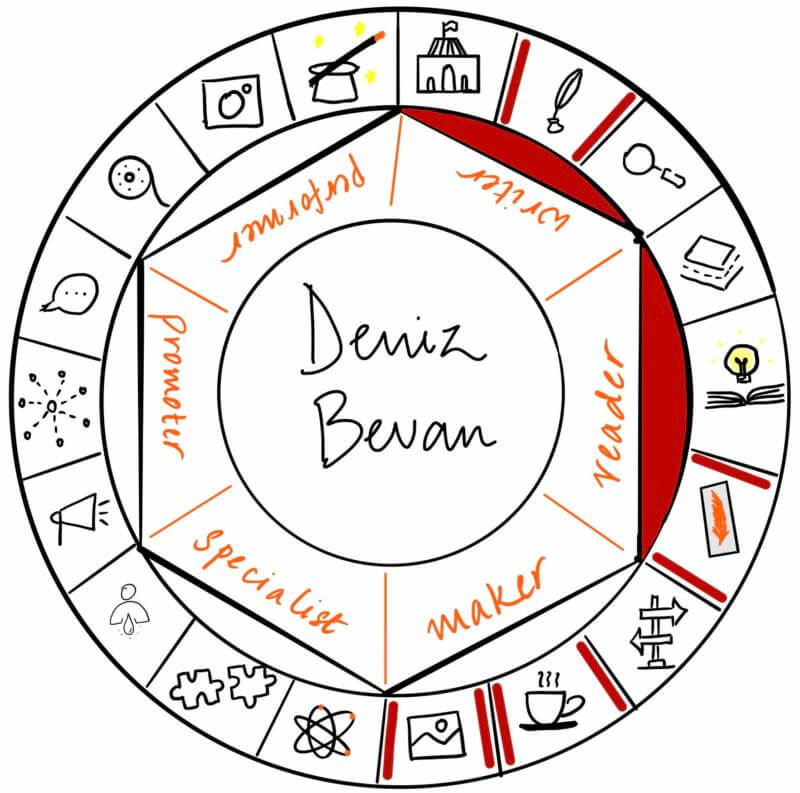Welcome friend! I love chatting with historical fiction authors and learning about how they do research for their books. On Creator’s Roulette today, I have author Deniz Bevan, sharing some tips and secrets. Her latest book, Druid’s Moon, is about an archaeologist.

Full-immersion Research
Guest post by Deniz Bevan
Every time I finish writing a story, I think, “next time I’ll write a contemporary novel set in my hometown, so I don’t have to do any research!”
In over three decades of writing, this has never happened…
Druid’s Moon started out simply enough. I had a dream, of a man and a woman in a storeroom in a cave, with the door barred, and antagonists on the other side of the door, doing their darndest to get in. Somehow, I knew that the man had been a beast, and that there were even more evil creatures in the depths of the cave, and they had to be defeated.
Then the plot thickened.
Collecting stories
Suddenly I had any number of themes and locations and languages to learn about. Immersion is necessary for historical aspects, in order to gain a real sense of past time periods. One of the best ways to do that is by, as author Clare O’Dea says, collecting stories: interviewing those you can, and reading the first-hand accounts of those from long ago. Research in the non-fiction aisles of the library is also necessary; not only textbooks but newspapers, catalogues, even shipping manifests or names of boats from your time period!
I try not to read fiction that is set in my period or genre until the novel is at the near-final edits stage. But there are two exceptions to this rule: poetry, and fiction in other languages. I have a 15th Century Castilian protagonist in one series, and for his sake I’ve read poetry from his time, and still have Don Quixote on my To Read pile!
Visiting locations
I’ve been to Cornwall! Not exactly the same towns as Lyne is in, but in the same neighbourhood. This aspect is not always easily accomplished (I long to be able to travel to the Highlands!) but having access to the sights and scents that your characters experience can only help make the descriptions stronger.
I also always seem to come up against pesky items such as train timetables and ferries that don’t run on the days I need them to! Other times, I’ll invent schools or other buildings out of whole cloth, then find out they’ve been there all along, exactly where I need them to be. Story serendipity gives one a good feeling.
Beta readers
Sometimes I quail at the questions that readers ask. How could I have missed x, y, z? But answering their questions and addressing their concerns only makes the story stronger. For her latest novel, The Actual Star, author Monica Byrne not only had beta readers, but any number of technical readers, for issues of language, location, plausibility, and more. There are so many details, in any story, that need to be dealt with!
Writing tips
Which means that craft advice is also a form of research!
I’m an avid reader of author Jo Bourne’s blog, as she has some of the best technical and craft-related advice out there.
While in the middle of earlier rounds of edits on Druid’s Moon, I also came across another piece of advice about extending the moment of surprise in a book featuring ghoulies and ghosties and other things that go bump in the night.
Druid’s Moon is my first paranormal, but I’ve written a couple of Young Adult stories featuring fantasy and time travel elements, and in all three, I’ve tried to have the characters responses go a little deeper than simply “oh, paranormal stuff. Cool.” I definitely think there’s room for more “What’s going on?!”-type reactions.
Courses
From the first draft of Druid’s Moon, I suddenly found myself with a main character who was an archaeologist.
So I took a Future Learn course in archaeology!
I confess, I also watched a lot of episodes of Time Team. Then I read their book, and a few other introductory books on archaeology. Finally, I showed the relevant bits to an archaeologist friend. As author’s notes always say, any remaining errors are entirely my own.
Of course, there’s also a Kraken in Druid’s Moon, so other kinds of research were also needed…
Music and images
That’s where music and images come in. Over the years, I’ve collated quite a few Kraken-like images, as well as variations on the Beauty and the Beast legend (Pinterest Board).
Other authors, such as Chrys Fey and Kait Nolan have playlists for their stories.
I have playlists not only for my own novels but for writers’ houseparties that I and my characters have attended! The starting notes of some songs take me right back to certain scenes and hep me recapture the moods I need to polish up the draft.
What’s your favourite aspect of story research?
Do you have songs that link to your stories?
Tell us what you like about them in the comments.
Thank you so much for joining us! Connect with Deniz on her two blogs – The Girdle of Melian and Purl One, Yarn Over, Purl Two Together, Knit One. Druid’s Moon is her latest novel and you can learn about it on Goodreads.
Cover image: Photo on Unsplash

Thanks so much for hosting me today!